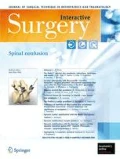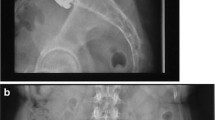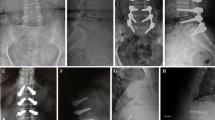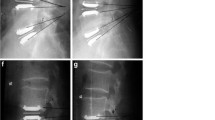Abstract
Degenerative disc disease at some stage requires surgical treatment to improve the pain situation. As opposed to fusion technologies, which bring immediate pain relief but that will again develop over the next years due to adjacent level disease, motion-sparing devices appear to avoid this condition. The ProDisc-L is a ball and socket design with a semi-constrained biomechanical concept implanted to replace the intervertebral disc. The surgical procedure has a minimal learning curve and a low complication rate, in treatment of low back pain. Long-term results in terms of radiological data, clinical data, and subjective scores like VAS, ODI, SF-36 show high patient satisfaction and indicate an equal or sometimes superior treatment option over fusion procedures.
Similar content being viewed by others
References
Szpalski M, Gunzburg R, Mayer M (2002) Spine arthroplasty: a historical review. Eur Spine J 11(Suppl 2):S65–S84
Bono CM, Garfin SR (2004) History and evolution of disc replacement. Spine J 4: 145S–50S
Marnay T (2001) Lumbar disc arthroplasty: 8-10-year results using titanium plates with a polyethylene inlay component. American Academy of orthopaedic surgeons annual meeting. San Francisco, CA
Tropiano P, Huang RC, Girardi FP, et al. (2005) Lumbar total disc replacement: seven to eleven year follow-up. J Bone Joint Surg Am 87: 490–496
Zigler J, Delamarter R, Spivak JM, et al. (2007) Results of the prospective, randomized, multicenter food and drug administration investigational device exemption study of the ProDisc-L total disc replacement versus circumferential fusion for the treatment of 1-level degenerative disc disease. Spine 32(11): 1155–1162
Auerbach JD, Yoder JH, Maurer PM, et al. (2007) Vertebral body augmentation with cortoss improves compression biomechanics for lumbar disc arthroplasty. Spine: affiliated society meeting abstracts. Scoliosis Res Soc, p. 239
Patel AA, Brodke DS, Pimenta L, et al. (2008) Revision strategies in lumbar total disc arthroplasty. Spine 33(11):1276–1283
Huang RC, Girardi FP, Cammisa FP Jr., et al. (2005) Correlation between range of motion and outcome after lumbar total disc replacement: 8.6 years follow-up. Spine 30(12): 1407–1411
Huang RC, Tropiano P, Marnay T, et al. (2006) Range of motion and adjacent level degeneration after lumbar total disc replacement. Spine J 6: 242–247
Bertagnoli R, Kumar S (2002) Indications for full prosthetic disc arthroplasty: a correlation of clinical outcome against a variety of indications. Eur Spine J 11(Suppl 2): S131–S136
Bertagnoli R, Yue JJ, Shah RV, et al. (2005) The treatment of disabling single-level lumbar discogenic low back pain with total disc arthroplasty utilizing the ProDisc prosthesis: a prospective study with 2-year minimum follow-up. Spine 30(19): 2230–2236
Bertagnoli R, Yue J, Shah RV, et al. (2005) The treatment of disabling multilevel lumbar discogenic low back pain with total disc arthroplasty utilizing the ProDisc prosthesis: a prospective study with 2 year minimum follow-up. Spine 30(19): 2192–2199
Anouble S, Donkersloot P, Le Huec JC (2004) Dislocations with intervertebral disc prosthesis: two case reports. Eur Spine J 13: 464–467
Bertagnoli R, Yue J (2007) Motion preservation in lumbar DDD with the ProDisc L prosthesis, 2-5-year results. Spine J 6: 42S–43S
Malter AD, McNeney B, Loeser JD, Deyo RA (1998) 5-year reoperation rates after different types of lumbar spine surgery. Spine 23(7): 814–820
Siepe CJ, Mayer HM, Heinz-Leisenheimer M, Korge A (2007) Total lumbar disc replacement-different results for different levels. Spine 32(7): 782–790
Siepe CJ, Mayer HM, Wiechert K, Korge A (2006) Clinical results of total lumbar disc replacement with ProDisc II. Three-year results for different indications. Spine 31(17): 1923–1932
Bertagnoli R, Yue JJ, Nanieva R, et al. (2006) Lumbar total disc arthroplasty in patients older than 60 years of age: a prospective study of the ProDisc prosthesis with 2-year minimum follow-up period. J Neurosurg Spine 4: 85–90
Panjabi M, Henderson G, Abjornson C, Yue J (2007) Multidirectional testing of one- and two-level ProDisc-L versus simulated fusions. Spine 32(12): 1311–1319
Bertagnoli R, Tropiano R, Zigler J, et al. (2005) Hybrid constructs. Orthop Clin N Am 36(3): 379–388
Bertagnoli R, Zigler J, Karg A, Voigt S (2005) Complications and strategies for revision surgery in total disc replacement. Orthop Clin N Am 36(3): 389–395
Yue J, Bertagnoli R, Fenk-Mayer A, et al. (2006) The concurrent use of lumbar total disc arthroplasty and adjacent level lumbar fusion: hybrid lumbar disc arthroplasty: a prospective study. Spine J 6(5): 152S
Author information
Authors and Affiliations
Corresponding author
Rights and permissions
About this article
Cite this article
Bertagnoli, R., Habbicht, H. The ProDisc-L lumbar prosthesis. Interact Surg 3, 209–213 (2008). https://doi.org/10.1007/s11610-007-0042-6
Published:
Issue Date:
DOI: https://doi.org/10.1007/s11610-007-0042-6




